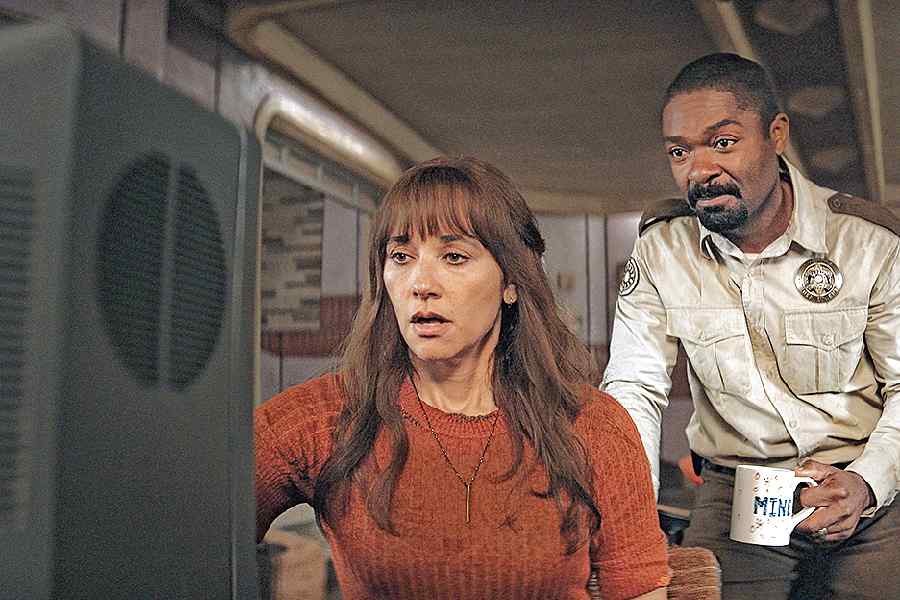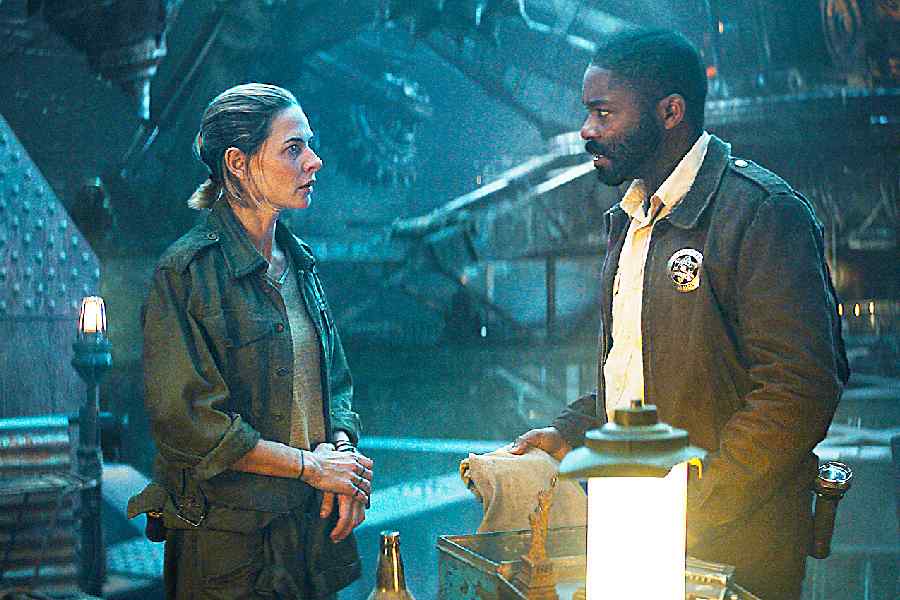When Hugh Howey’s self-published story Wool became a success in 2011, it was given a rude description by some: a sci-fi version of Fifty Shades of Grey. Howey was on his way to the elite club of writers while film studios wanted a piece of the action. Ultimately, it became a series of books — along with Wool, the series comprises Shift, Dust, three short stories, and Wool: The Graphic Novel. Finally, Apple TV+ has stepped in with an adaptation, which is one of the best sci-fi shows you can watch at the moment.
A world has been built underground. For the last few thousand years, people left alive on Earth have been living in a multilevel subterranean Silo, waiting for the planet to recover. No one knows what’s happening outside. Inside the Silo, there are hydroponic farms to medical centres, and the architecture is a reminder of steampunk, inspired by Victorian-era industrialism.
Sheriff Becker (played by David Oyelowo) has to maintain law and the mayor, Ruth (played by Geraldine James), has to ensure stability. If somebody wants to leave the Silo, there is no way to return. And whoever steps out will have to clean the glass, so that everyone inside gets a view of the world outside. Becker’s wife Allison (Rashida Jones) decides to leave and things get complicated. The other part of the story involves Juliette (Rebecca Ferguson), an engineer in charge of the furnace that keeps the Silo running.

Rashida Jones and David Oyelowo play husband-wife in the show

(Left to right) Common, Morten Tyldum, Hugh Howey, Tim Robbins, Harriet Walter, Rebecca Ferguson, Graham Yost, Chinaza Uche and Avi Nash at the world premiere of Apple TV+’s Siloat the Battersea Power Station in London
We spoke to the Apple TV+ show creator Graham Yost and the writer of the Silo series, Hugh Howey. Here’s what they said.
What are the challenges of translating a book series into a show? Were compromises made?
Hugh Howey: Actually, I was telling them: “Let’s change this, let’s do something else.” And Graham (Yost) would be, let’s stick to what’s there. I think that made me easy to work with because I think the best story you can tell depends on the medium you’re telling it in. So we stuck to the parts that I think are important, and no one wanted to change those anyway. But I wanted to tell the best story possible.
Graham Yost: Our standard joke in the writers’ room: Does it have to be a Silo? There was so much freedom that Hugh gave us, but also the structure was so strong that we had the freedom to work within that; we could relax. We knew how the season was going to end, right from the beginning. And it was how do we get from there? How do we get there? And we knew how we wanted to start it. It was just figuring out the bit in between and changing some things. But he was part of that and was very open to it: “Oh, that’s cool. Let’s try that.” And then we would ask him some things and he’d be like: “I don’t know, I wrote that 10 years ago. I don’t know why I did that.” That was fun.
Graham, when did you first come across the book series? What did you think of the book when you first read it?
Graham: I think I’ve read most of it. I can’t remember the actual year but I wasn’t working for Apple yet. I don’t know if Apple TV+ (launched in November 2019) existed at that point. I was still at Sony; it was finishing up a deal with having done Justified for them and we’re approached by the head honcho, saying: “There’s a feeding frenzy for these books. Would you take a look?” I read; I got it on my Kindle, the semi-graphic novel version, which was really fun. It was helpful. It was cool, a very visual thing. And I went: “Oh, this is awesome. I may throw my hat into the ring.” And we didn’t get it. AMC (Studios) got it. And then when I went to Apple, it turned out that Jamie Erlicht, who had been at Sony, was now at Apple with Zack Van Amburg. I’m a big fan of both. He said: “What about Wool (the short story that started the series of books)? What about Silo?” I said put my name back in the ring. And then we were lucky that Apple and AMC worked out a deal.
Since you brought up Wool, whoever leaves the giant Silo has to go out and clean the window. Where did you get the idea from? What’s the deeper meaning behind it?
Hugh: For me, it’s just about population control, like how do you get people to not be too hopeful too soon; get everybody riled up and think: “Hey, we need to go outside,” which can lead to people’s death. The worst thing is they want to see you go outside. And once you do, you get the idea that it’s nice not to show it to everyone else. And by complying and cleaning, everyone left inside sees that your will is broken; you’re having a completely different experience. But for people inside, they’re just shattered by this.
Graham: Yeah, that’s one of the things… that everyone says they’re not going to clean (when they go outside) and then they go out and they clean. And that was one of the mysteries that I loved in the story. “Well, what’s going on?” It was a compulsive read… all the books; you just want to find out what’s next.
Hugh, do people come up to you with new ideas and interpretations for the book series. Do you look back and think that you may have changed something? In hindsight, is there anything you want to change?
Hugh: Yeah, the hardest part about writing is that you have an infinite number of doors you can choose to walk through and just choosing one is the paralysis of a blinking cursor. So if I went back and rewrote it with what I know now and how many people would read this, it’d be impossible to write to be honest. It’s better to write with low expectations and a very small audience in mind. I think having more input and more ideas actually can create paralysis rather than lead you down a better path. I’m lucky. People have written a lot of fan fiction in this world and I’ve avoided all that because I’m scared of just giving me too many ideas.
Let’s talk about the character of Juliette Nichols, the engineer who keeps the generators going inside the Silo, so people can keep living. What made you paint her as some kind of a reluctant warrior?
Graham: The reluctant warrior to me is someone who doesn’t want to be put into a position of power and [it] is thrust upon them; this is, to me, more captivating than someone who’s egotistically seeking it out. For the reader or the viewer, it puts us in the mind: “Gosh, what if I was put in that situation? It’s not something I’ve wanted. But if I was put there, would I make good choices? And how would I survive?” So it’s better for the audience to have empathy.Hugh: I also think it’s someone who’s an engineer… my son is an engineer… there’s a certain kind of problem-solving attitude, and how can you fix this thing? How you can make this work? How can you create something that will work in this situation? So it’s sort of solving mysteries. I thought it was a cool idea to have this person who is not a detective, but she has really embarked on this path to solve the big mysteries of where they live. And that’s a fun character to have at the centre of your show.
Silo is streaming on Apple TV+










